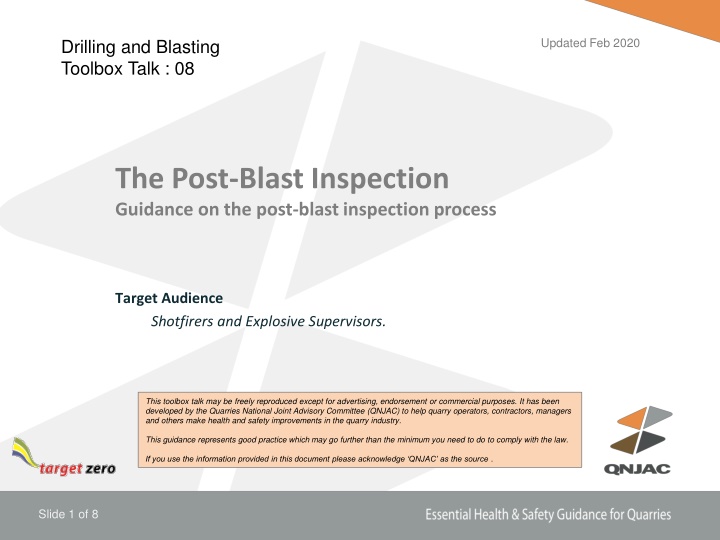
Blasting Hazards: Fumes, Dust, and Ground Falls
This toolbox talk focuses on the post-blast inspection process, emphasizing the responsibilities of shotfirers to ensure safety in the work area. Hazards such as fumes, dust, and falls of ground are highlighted, underscoring the importance of proper inspection procedures to prevent accidents.
Download Presentation

Please find below an Image/Link to download the presentation.
The content on the website is provided AS IS for your information and personal use only. It may not be sold, licensed, or shared on other websites without obtaining consent from the author. If you encounter any issues during the download, it is possible that the publisher has removed the file from their server.
You are allowed to download the files provided on this website for personal or commercial use, subject to the condition that they are used lawfully. All files are the property of their respective owners.
The content on the website is provided AS IS for your information and personal use only. It may not be sold, licensed, or shared on other websites without obtaining consent from the author.
E N D
Presentation Transcript
Updated Feb 2020 Drilling and Blasting Toolbox Talk : 08 The Post-Blast Inspection Guidance on the post-blast inspection process Target Audience Shotfirers and Explosive Supervisors. This toolbox talk may be freely reproduced except for advertising, endorsement or commercial purposes. It has been developed by the Quarries National Joint Advisory Committee (QNJAC) to help quarry operators, contractors, managers and others make health and safety improvements in the quarry industry. This guidance represents good practice which may go further than the minimum you need to do to comply with the law. If you use the information provided in this document please acknowledge QNJAC as the source . Slide 1 of 8
The Post-Blast Inspection 1. Introduction The Shotfirer has a responsibility to carry out a post-blast inspection The purpose of the inspection is to confirm that conditions are safe for work in the area to recommence In particular the shotfirer is looking for evidence of misfires and unsafe ground conditions Where a dangerous condition has resulted from the blast the shotfirer should maintain the Danger Zone and inform the Explosives Supervisor as soon as possible Shotfirers need to follow the manufacturers recommended minimum time after firing before carrying out the inspection particularly when using electronic detonators Most safety professionals consider the post-blast inspection to be the most hazardous part of the shotfiring job Slide 2 of 8
The Post-Blast Inspection 2. What are the hazards Fumes and dust All blasts will produce fumes and this is often accompanied by dust Both fumes and dust in excessive quantities can be harmful to health and exposure to them should be avoided See QNJAC TBT No 16 Post Blast Fumes WAIT UNTIL THE DUST AND FUMES HAVE CLEARED Slide 3 of 8
The Post-Blast Inspection 2. What are the hazards Falls of ground The blasting process inevitably results in some movement of the rock mass for some considerable distance from the blast area This can lead to falls of ground from both the benches above and below the blast These falls of ground can happen some considerable time after the blast has been fired and pose a serious threat to the safety of the shotfirer and any other personnel in the area Slide 4 of 8
The Post-Blast Inspection 2. What are the hazards Falls of ground The area of ground immediately surrounding the blast area can be especially unstable On buffer blasts care needs to be taken walking over the heaved up and fractured blasted area It is not unusual for overhangs to be left behind on the newly formed crest Edge protection should be placed behind and to the side of the shot before it is fired if possible The face will not have been dressed Slide 5 of 8
The Post-Blast Inspection 2. What are the hazards Slips, trips and falls The shotfirer needs to take great care when walking around and inspecting the blast due to uneven ground, voids and rocks they may encounter Misfires or burning explosives If the shotfirer discovers explosives that have either misfired or are burning then there is a clear danger of additional detonations with the associated risks of blast damage and flyrock In such cases the shotfirer should note their positions and Return to the shotfiring shelter Ensure that the all-clear is not sounded Ensure that all sentries stay in-place Inform the Explosives Supervisor of the situation The Shotfiring Rules for each quarry should include a section dealing with misfires and it is these procedures that should be followed in this event Slide 6 of 8
The Post-Blast Inspection 3. Minimising the risks Fumes and dust Make sure the shotfiring shelter is not positioned downwind of the blast area See QNJAC TBT 01 Positioning a Shotfiring Shelter Wait for the fumes and dust to clear Falls of ground Keep away from the toe of the face above and crest of the face below If possible inspect the blast muck-pile from the bench below Blasting may expose cavities in limestone quarries or old workings in opencast sites Inspect the blast muck-pile from the side Slide 7 of 8
The Post-Blast Inspection 4. Key points The post-blast inspection is potentially the most risky part of the shotfiring process After firing wait until the dust and fumes have cleared, following the manufacturers guidance on minimum times before inspecting Approach the blast area with care avoiding the toes and crest of faces Inspect the blast area from below or from the side of the blast Do not rush the inspection process Carry out the inspection in pairs, if not possible stay in communication Do not sound the all-clear until the inspection process is complete Slide 8 of 8
